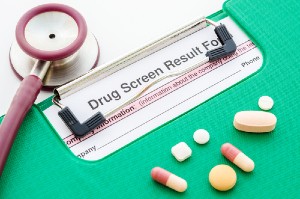How Long Does Fentanyl Stay in Your System?
Generally, fentanyl may be detected on urine tests for up to 3 days; however, detection times vary by test type and other factors.
What Is Fentanyl?
Fentanyl is a synthetic opioid painkiller that is used to treat severe pain or postsurgical pain. It is between 50 to 100 times more potent than morphine.1
Fentanyl is used in hospital settings as an injectable solution, but it may also be prescribed as an orally dissolving tablet, a spray, a transmucosal lozenge, or in extended-release transdermal patch formulations. But on the street, illicit fentanyl may be encountered as a powder, spiked on blotter paper, combined with or substituted for heroin, or sold as tablets that resemble other opioids.1
How Long Fentanyl Shows Up on a Drug Test

Detection times vary; however, depending on the test, fentanyl may be detected in:
- Urine for up to 3 days.
- Blood for up to 48 hours.
- Hair for up to 3 months.
Saliva tests are not reliable detectors of fentanyl.
There is no way to tell exactly how long fentanyl will be detectable in your system. The only way to pass a drug test is to stop using drugs. Treatment can help. Give us a call to learn more about your options at .
Factors That Impact How Long Fentanyl Stays in Your System
How long a drug will stay in a person’s system is impacted by its half-life (which will vary by the kind of drug and the specific form) and by how quickly a person metabolizes the drug.
Fentanyl Half-Life
A drug’s half-life is the period it takes for its concentration in the blood to drop by 50%.3 Fentanyl’s half-life can vary depending on how it is administered or misused.
- Intravenous fentanyl: The half-life is between 2 and 4 hours, depending on the size of the dose.4
- Transdermal fentanyl: Often administered via patches, the half-life of the drug when taken in this manner is about 17 hours.5
- Transmucosal fentanyl: When fentanyl is orally consumed, often in the form of lozenges, it has a half-life of anywhere from 5 to 14 hours, depending on the specific transmucosal formulation.6
Fentanyl Metabolism
Drug metabolism refers to several biochemical alterations of drugs to facilitate their elimination from the body. Many variables can play into a person’s ability to metabolize a drug. These include:
- Age.
- Gender.
- Body mass.
- Body fat percentage.
- Hydration status.
- Liver function.
- Genetics.
How Do Drug Tests Detect Fentanyl?
- Urine test: Fentanyl is usually not tested on routine drug screenings. Fentanyl-specific toxicology must be specially requested. Studies have shown that fentanyl can show up in urine for up to 24 hours, but is not likely to be detectable beyond 72 hours. Norfentanyl, a metabolite of fentanyl that is produced as the body breaks down the drug, may be detectable for up to 96 hours on some tests.7
- Blood test: One study of post-surgical blood measurements suggests that fentanyl may be detectable in the blood for 5-48 hours depending on the dose (2000 micrograms vs 5000 micrograms). Norfentanyl can remain in the blood for 4 hours.8
- Hair test: Hair tests can detect drugs such as fentanyl for up to 3 months.9
- Saliva test: Even when fentanyl is consumed in lozenge form, it is difficult to detect in the saliva, so this type of drug test is unreliable.7
Effects of Fentanyl

While a valuable medication for those with severe, chronic pain,1 fentanyl is extremely potent and may be misused by people who seek its euphoric effects. They may steal it, forge prescriptions, or get it through patients, physicians, and pharmacists.
In other cases, it may be inadvertently used as an adulterant of heroin. Much of the current fentanyl misuse and opioid overdose epidemic involves illegally manufactured fentanyl.2
Fentanyl’s potency greatly increases the risk of drug overdose. It acts on areas of the brain that control breathing, which can lead to pronounced respiratory depression and death. People may not be aware that they are using fentanyl, since illicit forms of the drug are sometimes found mixed with heroin or cocaine.1
Fentanyl Addiction Treatment in Nevada
If you’re misusing opioids, the likelihood of addiction or fatal overdose is very high. You can prevent overdosing on fentanyl by seeking treatment for opioid addiction.
If you or someone you care about are struggling with fentanyl or other drugs, call to learn more about our inpatient rehab in Las Vegas or outpatient rehab. Admissions navigators can help you start the admissions process today, explore ways to pay for rehab like using insurance to cover addiction treatment, or go over the different levels of rehab offered at Desert Hope.